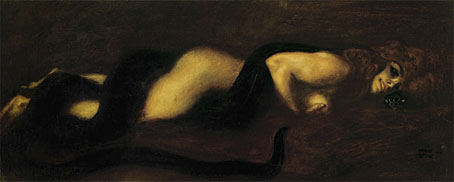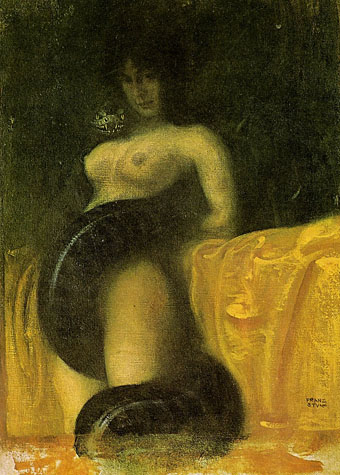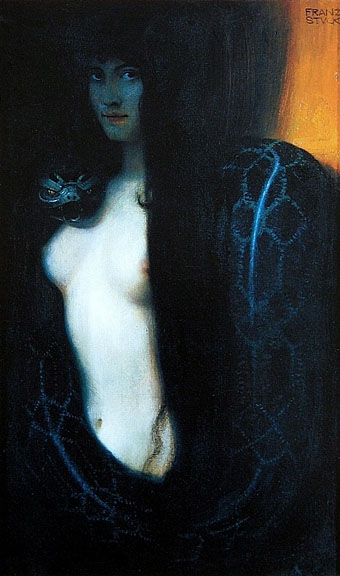
The Sin (1894).
Some pictures in honour of the Chinese year of the Water Snake which begins this Sunday. Paintings of women with snakes are legion, even after you winnow out all the Eve and the Serpent pictures, so you need to narrow the field of view. Artists of the 19th century must have been delighted when Gustave Flaubert published Salammbô in 1862, chapter 10 of which—The Serpent—gave them an excuse to depict an exotic woman involved with a snake completely free of any Biblical trappings.

Sensuality (1891).
Franz Stuck’s celebrated trio of serpent women can be read as Eve figures but their provocative posing is more in line with the prurient misogyny common to much art of the period, an attitude which condemned women for being so tempting whilst also secretly lusting after their bodies. Sensuality is remarkable for the way its oiled snake is so firmly lodged between the woman’s thighs. Stuck was never very interested in Christian themes—many of his other works are a Teutonic take on Classical subjects—so I wonder whether his use of the word “sin” was merely a fig leaf for delivering imagery he wouldn’t have otherwise been able to exhibit.
The Sin (1893).

Sin Dance (1966) by Wes Wilson.
Symbolist art was rediscovered in the 1960s after decades of neglect, and the psychedelic poster artists happily plundered the art books for suitable imagery. Stuck’s Sin returned to the world in these two Avalon Ballroom posters. Wes Wilson’s Sin Dance was a design for an event which was cancelled so this might explain why the same painting appeared a few months later on a Stanley Mouse and Alton Kelley poster. The Mouse & Kelley version was printed with metallic inks.
For more of Franz Stuck’s work see WikiPaintings.

Jefferson Airplane at the Avalon Ballroom (1966) by Mouse & Kelley.
Previously on { feuilleton }
• Serpentine pulchritude
• Salammbô illustrated
• The Feminine Sphinx
• Men with snakes


I love Franz Stuck and the posters are just magnificent. Great entry. Speaking of Eve and the Serpent did you receive my question about Frank C. Pape?
Yes, I got your mail, thanks. Sorry I didn’t respond, I’ve been really busy the past two weeks, the posting here has had to be mostly done in a rush as a result.
I might have written something about Papé already if there’d been a decent one-stop-shop for his work which is mostly scattered around the web. I like it with some reservations, mainly that his drawing tends towards the comic–as does Cabell’s writing–whereas I prefer things that tend towards the weird and exotic. I’m thinking of things like this which are more comical than horrifying:
http://www.flickr.com/photos/lineae/5870107114/
There’s a parallel there with Sidney Sime who also did comic illustrations but was slightly more original in his imaginings. That said, there’s more of Papé’s work around now so it may be the time to look for the best of it.
[Emphasis mine]
Doesn’t it take more than a denial of something to make it a secret? Hypocrisy often involves make-believe, rather than a genuine attempt to deceive one’s audience.
Surely, when men speak to each other of women being tempting, speaker and listener each understand the other to see and feel the thing: “how unreasonable of them to tempt us!”
The paintings don’t need to show lustful men to be understood, after all. And no special education in artistic conventions is required–for the intended audience, at least.
Of course, sometimes the claim that women are tempting will be insincere–just one more stick with which to beat womankind–, but then there is unlikely to be lust.
(Fingers crossed no unclosed tags, this time.)
Hi John, I just wondered if the email was out of date but I’m sorry if I seemed pushy by that comment. I really like comic things and coupled with the fantastic imagery Pape really is “my cup of tea.” That goes for Cabell as well of course. One of the worst parts about Cabell’s work is it kind of hodge podge what is and isn’t up on the internet. One of my favorites “The Silver Stallion” isn’t up and it has some of the best illustrations. The Eve and the Serpent illustration I really like isn’t up either since it’s found in “The High Place.”
After your Judith and Holofernes post I looked into more of it and found Stuck’s “Judith” which I thought was wonderful.
Anyways I really enjoyed the post.
I wonder whether his use of the word “sin” was merely a fig leaf for delivering imagery he wouldn’t have otherwise been able to exhibit.
He painted, what, half-a-dozen different versions of the painting. He knew what his clients wanted.
IIRC another of his themes was ’emasculating / beheading women’ (Salome, Judith, Circe, Sphinx), fitting into an earlier Feuilleton post. Stuck exemplifies Bram Dikkstra’s “Idols of Perversity” thesis so neatly that I half-suspect Dijkstra of going back in a time machine and inventing him.
G: Ha, no, it wasn’t pushy. One of the good things about doing these posts is the way they make you search around a bit more than you otherwise might for the more obscure artists. Doing that sometimes makes you reverse a perception about somebody. Willy Pogány was a good example, I had him in the category of artists I wasn’t very interested in until finding things like his Wagner illustrations which are in a completely different style to everything I’d seen of his before. Papé seems somewhat similar, there’s a comic style and also a more serious side to his work. The latter I hadn’t seen before so that’s an area to look into.
herr doktor bimler: I’ve got Dijkstra’s book. A good thesis which I’ve referred to at least once in the past, even though he gets a little overwrought at times. Worth it for the pictures alone, some of which I’ve never seen reproduced anywhere else.